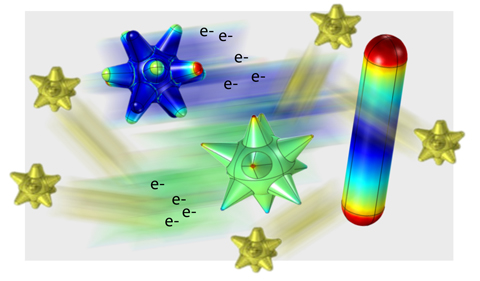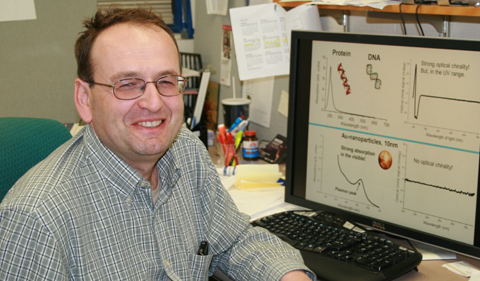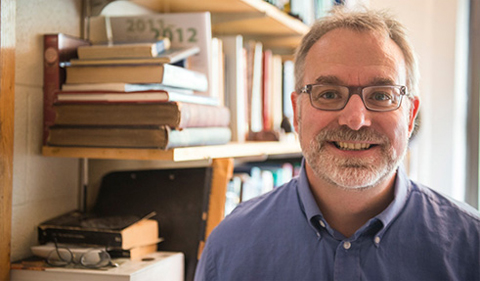
Artist concept of ultrafast energetic electrons injected from gold nanocrystals in recent experiments on photophysics. Images: Alexander O. Govorov/Artist: Katharina Gleissberg
Direct observation of ultra-fast energetic (hot) electrons created by light photons in plasmonic nanodevices has been a nearly impossible task until now.
A research team led by Dr. Alexander Govorov, Distinguished Professor of Physics & Astronomy at Ohio University, published a paper on “The fast and the furious: Ultrafast hot electrons in plasmonic metastructures. Size and structure matter” in Nano Today, an international journal with a high impact factor covering nanoscience and technology.
Other team members include former OHIO postdoctoral researcher Lucas V. Besteiro, who is a joint Postdoctoral Fellow at the Institute of Fundamental and Frontier Sciences (UESTC, China) and the Institut national de la recherché scientifique (INRS, Canada), scientists from University of Notre Dame and Argonne National Laboratory, as well as from China and Germany.
“The fast and the furious’ paper concerns a topic that is currently receiving a great deal of attention from nanomaterial scientists,” Govorov said. “Light photons are able to create some number of high-energy electrons in plasmonic nanodevices. Such electrons can be used for solar photoreactions, for example. Those electrons are ultra-fast to relax and until recently nobody could catch them directly in the time-resolved spectroscopy.”
Plasmonic nanodevices are nanostructures incorporating metal components with free carriers that create very strong optical responses such as absorption, scattering and generation of hot carriers. Typically, in a nanodevice, optically active plasmonic components are interfaced with semiconductor or polymer layers.
Previously, a collaborative team from Senior Scientist Gary Wiederrecht’s group at Argonne National Laboratory and Govorov’s team at OHIO reported such signals in the journals Nature Nanotechnology (2015) and Nature Communication (2016), where they designed meta-structures with special geometries.
“This problem of ultra-fast energetic electrons has long history starting from the famous equation derived by Lev Landau for the lifetime of quasi-particles within the Fermi liquid theory developed during 1956-1958,” explained Govorov. “We are pushing the fundamental understanding of nanostructures and nanotechnology further, to the new areas and challenges and simultaneously work on useful applications, such solar photocatalysis, biochemistry and photodetectors.




















Comments